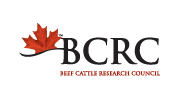Identifying cattle that are more likely to be E.Coli 0157 super-shedders
| Project Code: | FOS.07.17 |
| Completed: | In Progress. Results expected in March 2022. |
Project Title:
Identification of genetic and microbial markers for E. coli O157 super-shedders through longitudinal biopsy and monitoring
Researchers:
Leluo Guan Ph.D. (University of Alberta) leluo.guan@ualberta.ca
Leluo Guan Ph.D. and Graham Plastow Ph.D., (University of Alberta); Tim McAllister Ph.D., (Agriculture Agri-Food Canada Lethbridge); Kim Stanford Ph.D., (Alberta Agriculture and Forestry); Tom McNeilly Ph.D., (Moredun Research Institute)
Background:
Packing plants have improved their control of E. coli O157:H7 and recalls due to E. coli O157:H7 in beef are becoming rare, in 2014 Canada had 10 E. coli O157 related recalls and only one involved beef. Cattle are thought to be the main reservoir for E. coli O157:H7. Fewer than 10% of cattle are thought to be the “supershedders” that contribute the most to the problem. On-farm sampling is of limited value because some supershedders shed longer than others. Previous research has identified genes related to suppressed immunity in the rectum that were related to supershedding in a very small number of animals. This project will validate these genes and study them further.
Objectives:
To determine what causes some cattle to be supershedders and recommend improved techniques to mitigate E. coli O157 in beef cattle.
What They Will Do:
1000 cattle will be rectally biopsied and fecal sampled on arrival at AAFC Lethbridge. DNA markers will be screened to identify potential high and low shedders (at least 3% or 30 cattle per group). These will then be sampled weekly to monitor shedding over a four-month period.
Using gene markers identified in an earlier study, the repeated rectal samples will be analyzed to monitor how gene expression changes at different stages of supershedding, and relate these changes to the bacteria found in the fecal sample.
Gene expression of both the host and the bacterial population will be compared between super-and low- shedders to identify possible mechanisms related to colonization and shedding in both the bacteria and the host. The team will look for SNP markers in the genes (DNA) that are differentially expressed between the super- and low-shedders.
The E. coli O157:H7 isolates collected will be whole-genome sequenced to look for genes related to the heat, acid and sanitizer tolerance identified in FOS.01.17, differences in pathogenicity (virulence, toxin and adherence genes), or differences in colonization.
Implications:
This project will define the interactions between cattle and bacteria that determine why some animals become supershedders, which is a critical step to developing more effective on-farm and/or in-plant interventions against E. coli O157:H7, and further improving the safety of Canadian beef.








